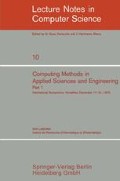Abstract
In this paper, authors present a formulation and some computational details dealing with a general elastic/visco-plastic material where nonlinear elasticity is admissible and the flow rule and yield condition need not be associated.
If, in a visco-plastic solution method, stationary conditions are reached for the displacements, the solution to an equivalent plasticity problem is obtained. The visco-plastic approach thus provides an alternative technique to solve elasto-plastic problems, and which is found to possess considerable merits vis à vis other iterative processes.
In particular, non-associated flow rules and strain softening can be dealt with in a general purpose program without requiring specific numerical artifices. Further, by providing always an equilibrating solution (within the approximations of the finite element discretisation) and, at displacements stationarity, ensuring a plastically admissible stress distribution, results always give a lower bound to collapse.
The paper includes several examples to illustrate the application of the method to some problems of practical interest.
Preview
Unable to display preview. Download preview PDF.
References
APPLEBY, E. J. and PRAGER, W. ‘A problem in visco-plasticity’ J. Appl. Mech., 29, 381–384 (1962).
ARGYRIS, J. H. and SHARPF, D. W. ‘Methods of elasto-plastic analysis'. Symp. on Finite Element Techniques, Stuttgart (1969).
BAUER, F. and REISS, E. L. ‘On the numerical determination of shrinkage stresses'. A.S.M.E. Trans., J. Appl. Mech., March 1970, 123–27 (1970).
BINGHAM, E. C. ‘Fluidity and Plasticity’ Chapter VIII, 215–218, McGraw-Hill, New York (1922).
CHABOCHE, J. L. ‘Calcul des déformations visco-plastiques d'une structure soumise à des gradients thermiques évolutifs’ Faculté des Sciences d'Orsay. Paris. Thèse (1972).
DINNO, K. S. and GILL, S. S. ‘An experimental investigation into the plastic behaviour of flush nozzles in spherical pressure vessels’ Int. J. Mech. Sci., 7, 817 (1965).
DRUCKER, D. C., PRAGER, W. and GREENBERG, H. J. ‘Extended limit design theorems for continuous media’ Quart. Appl. Math., 9, 381–389 (1952).
FREUDENTHAL, A. M. and GEIRINGER, H. ‘The mathematical theories of the inelastic continuum’ Encyclopedia of Physics, Vol. VI, 229–433 (1958).
GREENBAUM, G. A., and RUBINSTEIN, M. F. ‘Creep analysis of axisymmetric bodies using finite elements'. Nucl. Eng. and Design, 7, 4, 378–397 (1968).
LEMAITRE, J. ‘Elasto-visco-plastic constitutive relations for quasi-static structures calculations’ ONERA publication TP 1089 — Chatillon (France) (1972).
MARCAL, P. V., and KING, I. P. ‘Elastic plastic analysis of two dimensional stress systems by the finite element method'. Int. J. Mech. Sci., 9, 143–155 (1967).
NAYAK, G. C. and ZIENKIEWICZ, O. C. ‘Convenient form of stress invariants for plasticity’ Proc. A.S.C.E., 98, ST4, 949–954 (1972).
NAYAK, G. C. and ZIENKIEWICZ, O. C. ‘Elasto-plastic stress analysis. Generalization for various constitutive relations including strain softening'. Int. J. Num. Meths. in Eng., 5, 113–135 (1972).
NGUYEN, Q. S. and ZARKA, J. ‘Quelques méthodes de résolution numérique en élastoplasticité classique et en élastoviscoplasticité’ Séminaire Plasticité et Viscoplasticité, Ecole Polytechnique, Paris (1972).
PERZYNA, P. ‘Fundamental problems in viscoplasticity’ Advances in Applied Mechanics, 9, 243–377 (1966).
REINER, M. ‘Rhéologie théorique’ Dunod, Paris (1955)
SUTHERLAND, W. H. ‘AXICRP. Finite element computer code for creep analysis of plane stress, plane strain and axisymmetric bodies’ Nucl. Eng. and Design, 11, 269–285 (1970).
TREHARNE, G. ‘Applications of the finite element method to the stress analysis of materials subject to creep’ Ph.D. thesis, University of Wales, Swansea (1971).
WHITE, J. L. ‘Finite elements in linear viscoelasticity’ Proc. 2d. Conf. Matrix Methods Struct. Mech. AFFDL-TR-68-150, pp. 489–516, Wright-Patterson A.F.B., Ohio (1968).
WIERZBICKI, T. ‘A thick-walled elasto-visco-plastic spherical container under stress and displacement boundary value conditions'. Archiwum Mech. Stos. 2, 15, 297–308 (1963).
WIERZBICKI, T. ‘Impulsive loading of rigid viscoplastic plates’ Int. J. Solids and Struct., 3, 635–647 (1967).
WIERZBICKI, T. and FLORENCE, A. L. ‘A theoretical and experimental investigation of impulsively loaded clamped circular viscoplastic plates'. Int. J. Solids and Struct., 6, 553–568 (1970).
ZARKA, J. ‘Généralisation de la théorie du potentiel multiple en visco-plasticité'. J. Mech. Phys. Solids, 20, 179–195 (1972).
ZIENKIEWICZ, O. C., WATSON, M. and KING, I. P. ‘A numerical method of visco-elastic stress analysis’ Int. J. Mech. Sci., 10, 807–827 (1968).
ZIENKIEWICZ, O. C. and VALLIAPPAN, S. ‘Analysis of real structures for creep, plasticity and other complex constitutive laws'. Int. Conf. on Struct., Sol. Mech., Eng. Design and Civ. Eng. Mat., Southampton (1969).
ZIENKIEWICZ, O. C., VALLIAPPAN, S. and KING, I. P. ‘Elasto-plastic solutions of engineering problems. Initial stress, finite element approach'. Int. J. Num. Meths. Eng., 1, 75–100 (1969).
ZIENKIEWICZ, O. C. ‘The finite element method in Engineering science’ McGraw-Hill, London (1971).
ZIENKIEWICZ, O. C. and CORMEAU, I. C. ‘Viscoplasticity solution by finite element process'. Archives of Mechanics, 24, 5–6, 873–888 (1972).
Author information
Authors and Affiliations
Editor information
Rights and permissions
Copyright information
© 1974 Springer-Verlag Berlin Heidelberg
About this paper
Cite this paper
Zienkiewicz, O.C., Cormeau, I.C. (1974). Visco-plasticity and plasticity an alternative for finite element solution of material nonlinearities. In: Glowinski, R., Lions, J.L. (eds) Computing Methods in Applied Sciences and Engineering Part 1. Lecture Notes in Computer Science, vol 10. Springer, Berlin, Heidelberg. https://doi.org/10.1007/BFb0015179
Download citation
DOI: https://doi.org/10.1007/BFb0015179
Published:
Publisher Name: Springer, Berlin, Heidelberg
Print ISBN: 978-3-540-06768-9
Online ISBN: 978-3-540-38374-1
eBook Packages: Springer Book Archive

